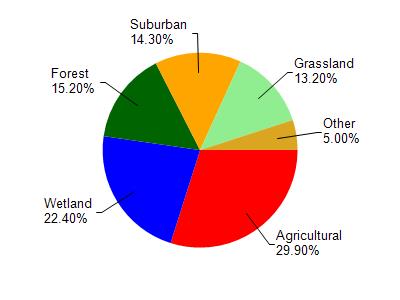Waukesha
No
No
No
Fish and Aquatic Life
Overview
Rock River Water Quality Management Plan, Lower Rock River Appendix. WT-668-2002. South Central Region, WDNR.
Lower Nemahbin Lake is a natural drainage, mesotrophic lake on the Bark River that supports a good warm water sport fishery. This partner lake to Upper Nemahbin also maintains Class IA water quality and experiences similar watershed pressures. Sediment and nutrient loads from upstream; surrounding septic systems; runoff from agricultural fields, lake homes and cottages; and runoff from the adjacent Interstate highway affect the lake's water quality. A Lakes Planning Grant could fund development of a watershed inventory of vegetation, as the lake's native vegetation of Chara and Vallisneria are likely affected by the non-native Eurasian water milfoil infesting the lake. There is also interest in developing sewer lines around this lake, which may protect the water quality during high flows.
Date 2002
Author Aquatic Biologist
Historical Description
Source: 1963, Surface Water Resources of Waukesha County Lower Nemahbin Lake T7N, R17E, Sections 24 and 25
A natural drainage lake bordering the terminal moraine. A low head structure on the Bark River below the lake serves to maintain the water level. The basin is divided due to the presence of one large island and several lesser ones. The water is clear and much of the bottom is marl. The fishery is comprised of pan fish, largemouth bass, northern pike and walleyes. Access is afforded by a launching site on the river channel upstream from the lake; both inlet and outlet are traversable by boat.
Surface Acres = 271,-S.D.F. = 1.43, Maximum Depth = 36 feet
Date 1963
Author Surface Water Inventory Of Wisconsin
Condition
Wisconsin has over 84,000 miles of streams, 15,000 lakes and milllions of acres of wetlands. Assessing the condition of this vast amount of water is challenging. The state's water monitoring program uses a media-based, cross-program approach to analyze water condition. An updated monitoring strategy (2015-2020) is now available. Compliance with Clean Water Act fishable, swimmable standards are located in the Executive Summary of Water Condition in 2018. See also the 'monitoring and projects' tab.
Reports
Recommendations
Lakes Planning Grant
The Lower Nemahbin Lake Association should apply for a WDNR lakes planning grant to fund a lake basin inventory of vegetation in and around Lower Nemahbin Lake.
Management Goals
Wisconsin's Water Quality Standards provide qualitative and quantitative goals for waters that are protective of Fishable, Swimmable conditions [Learn more]. Waters that do not meet water quality standards are considered impaired and restoration actions are planned and carried out until the water is once again fishable and swimmable
Management goals can include creation or implementation of a Total Maximum Daily Load analysis, a Nine Key Element Plan, or other restoration work, education and outreach and more. If specific recommendations exist for this water, they will be displayed below online.
Monitoring
Monitoring the condition of a river, stream, or lake includes gathering physical, chemical, biological, and habitat data. Comprehensive studies often gather all these parameters in great detail, while lighter assessment events will involve sampling physical, chemical and biological data such as macroinvertebrates. Aquatic macroinvertebrates and fish communities integrate watershed or catchment condition, providing great insight into overall ecosystem health. Chemical and habitat parameters tell researchers more about human induced problems including contaminated runoff, point source dischargers, or habitat issues that foster or limit the potential of aquatic communities to thrive in a given area. Wisconsin's Water Monitoring Strategy was recenty updated.
Grants and Management Projects
Monitoring Projects
| WBIC | Official Waterbody Name | Station ID | Station Name | Earliest Fieldwork Date | Latest Fieldwork Date | View Station | View Data |
|---|
| 827000 | Lower Nemahbin Lake | 10017612 | Nemahbin Lakes Access off Delafield Road | 9/3/2004 | 9/7/2025 | Map | Data |
| 827000 | Lower Nemahbin Lake | 683388 | Lower Nemahbin - Deep Hole West | 4/26/1997 | 8/16/2021 | Map | Data |
| 827000 | Lower Nemahbin Lake | 683255 | Lower Nemahbin Lake - Deep Hole | 9/18/1980 | 10/14/2025 | Map | Data |
| 827000 | Lower Nemahbin Lake | 683389 | Lower Nemahbin - Deep Hole North | 4/26/1997 | 6/20/2000 | Map | Data |
| 827000 | Lower Nemahbin Lake | 10007242 | Lower Nemahbin Lake | 8/1/1978 | 9/12/2022 | Map | Data |
| 827000 | Lower Nemahbin Lake | 999129 | Lower Nemahbin Lake - Deep Hole | 7/5/1988 | 8/5/1990 | Map | Data |
| 827000 | Lower Nemahbin Lake | 683455 | Lower Nemahbin Lake - Walk/Carry-in Access off Sugar Island Road | 8/17/2008 | 7/21/2024 | Map | Data |
|

Watershed Characteristics
Lower Nemahbin Lake is located in the Bark River watershed which is 185.84 mi². Land use in the watershed is primarily agricultural (29.90%), wetland (22.40%) and a mix of forest (15.20%) and other uses (32.50%). This watershed has 265.69 stream miles, 3,499.26 lake acres and 22,145.94 wetland acres.
Nonpoint Source Characteristics
This watershed is ranked Medium for runoff impacts on streams, High for runoff impacts on lakes and High for runoff impacts on groundwater and therefore has an overall rank of High. This value can be used in ranking the watershed or individual waterbodies for grant funding under state and county programs.However, all waters are affected by diffuse pollutant sources regardless of initial water quality. Applications for specific runoff projects under state or county grant programs may be pursued. For more information, go to surface water program grants.